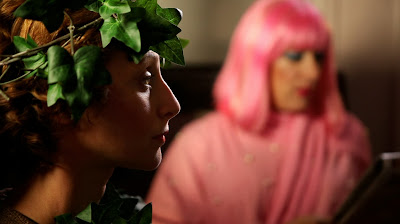The Best Way to Shoot Mirrorless Video with Creative Focus Control?
Creative Focus Control Everywhere is Not Easy
Which is awesome except for the part about keeping things in focus when the plane of focus is so narrow. And when the subject is moving. And when you want to shift the focus to a new subject. All that is hard. [Choosing what and when to focus on, and using that as a way to guide and inform viewers, we call that “creative focus control”]. On top of that, we want selective focus on all shots: handheld, sticks, shouldermount, gimbal, crane, Steadicam, you name it. And if that weren't enough, no downtime between setups. No one wants to see you fiddling with gear or re-rigging setups while the clock is running and everyone’s waiting.
How do We Solve the 'Creative Focus Gap' Challenge?
So basically the challenge was this: How do we outfit our tiny but powerful cameras with a rig that has enough stability to shoot handheld, has creative focus control, and is still small and portable enough (including all the necessary components) to work instantly on any setup?
Sean Sekino does a great job explaining the challenges of being an owner/operator and how he's been using the Scout to get the job done.
Sean Sekino talks about challenges and solutions
for modern owner/operator
for modern owner/operator
That's why we built the Scout: a compact rig for your mirrorless or DSLR camera that has integrated focus controls (for you or a focus puller, switching between them instantly) great handheld ergonomics (think a matching grip to the camera’s own), includes everything you need right on the camera, and can be easily moved between rigs without having to rebuild.
If you rely on mirrorless cameras and using selective focus to enhance your story, check out the Scout. It might be the perfect solution for how you shoot today.
The new Scout Active Cage: The Owner/operators companion for
support and creative focus control of your mirrorless or DSLR camera
support and creative focus control of your mirrorless or DSLR camera
8 Great Features Now Available in Scout
When we previewed Scout at NAB 2015, we took the great response and feedback from our customers and show attendees, and now the Scout has eight new features that raise the bar as an unbeatable production companion:
- Wireless-ready - just turn on the hand unit and your AC is ready to pull focus up to 1 mile away.
- Integrated control panel on the rear of the cage with full control of setup and configuration (most of the electronics are located at the base, making balancing easier)
- Power with standard Canon LP-E6 batteries: A great choice that’s standard, available everywhere, and chances are you already have some
- Rhino Mount – a superior way to mount the focus motor in as little space as possible
- Additional top shoe mount (2 total) for greater options in motor placement and accessory support (like on-camera mic)
- A universal top arm that’s adjustable for all supported camera models
- Additional adjustments for three-axis balancing of camera
- External fingerwheel support – Switch to external fingerwheel for shouldermount or gimbal focus control.
Check Out Limited Time Introductory Pricing on Scout
Scout now comes in two options: The Scout HX is the full-featured version including all the focus control components (Torque motor and integrated basestation) and is for anyone starting from the ground up. The Scout HS is for microRemote owners who want to add the Scout rig with the built-in fingerwheel and onboard power while using their existing microRemote Torque motor basestation.
The Scout HX
The Scout HX
The Scout HS (for microRemote customers)
For full details on the Scout http://store.redrockmicro.com/scout.html


















